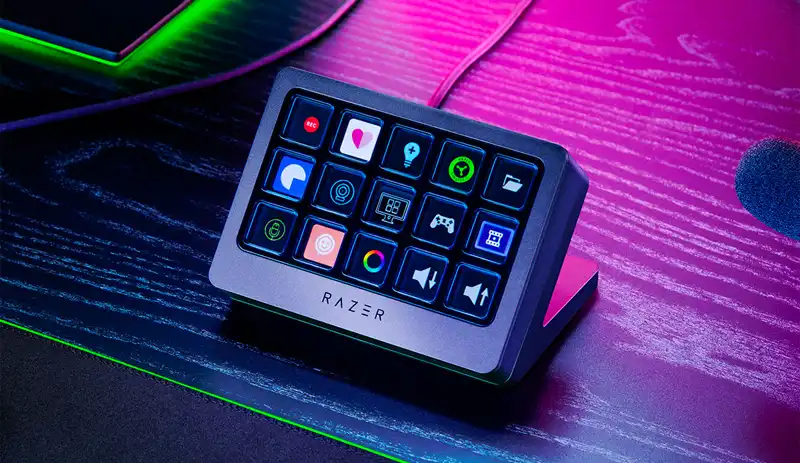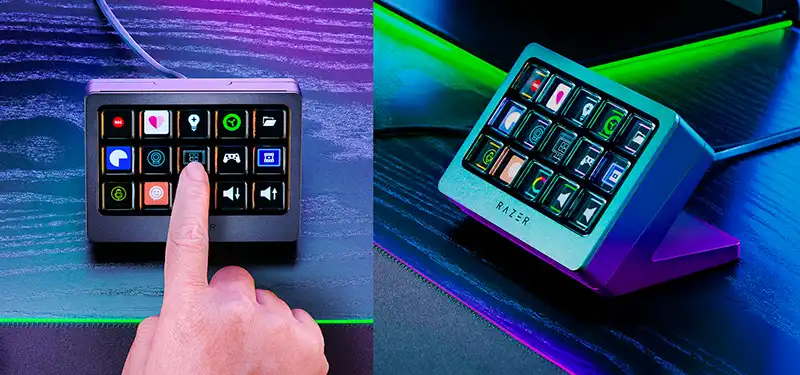You can also be interested in these:
In this review, we will take a closer look at the Razer Stream Controller X, a device that aims to cater to streamers who require specific functions and less variety for content creation, as opposed to the regular Stream Controller.
The Razer Stream Controller X features a panel of 15 switchblade buttons, without dials, with an integrated LCD screen that allows for easy programming of the buttons’ image and function through Loupedeck. Additionally, it offers ergonomic options thanks to its removable magnetic base and replaceable faceplate.

Exterior design
When it comes to design, the Razer Stream Controller X prioritizes comfort and functionality for creators. It boasts compact dimensions and comes with an additional base for flexible placement options.
The control panel has a rectangular format with 15 buttons arranged in three rows and five columns. Each button features a smooth, transparent plastic surface measuring 16 x 16 mm with rounded corners and separated by a 3 mm plastic grid. The total dimensions of the panel are 80 mm in height and 112 mm in width.
The faceplate, or top cover, is also removable and made of rigid plastic with four magnetic anchors on the edges, allowing for easy customization or modification. The device’s base is also made of plastic and has three anti-slip rubber feet that provide stability when placed directly on the ground. It features a small incline for better access and a central slot for the detachable USB Type-C cable. The base’s top surface is magnetized, allowing for easy attachment to metallic surfaces.
The Razer Stream Controller X also comes with a detachable base that allows for a 50-degree forward tilt, improving accessibility from afar. This base is built on a unibody frame and has a flat plastic surface that provides excellent grip on any surface, and it is magnetized for easy placement on metallic surfaces. However, this surface is prone to getting dirty easily.
Control panel
Focusing on the control panel, it resembles an Elgato Stream Deck or a Loupedeck Live S. In this case, the panel is specifically designed for streamers, offering only interactive buttons without dials. It’s suitable for different streaming types, such as just-chatting, gaming, or networking, and offers functionality for editing software.
The panel consists of 15 switchblade buttons, featuring physical switches instead of the touch input found on the Razer Stream Controller. Each button has a color LCD screen that can be programmed with icons, images, or GIFs to represent the assigned function.
The switches have a short travel distance, are very quiet, and have good cushioning at the end of the stroke. The actuation force is medium to high, which may cause the device to tilt slightly forward when placed on a base and a mat. Perhaps a softer switch or a heavier base would be beneficial. Technically, there’s not much more to it; it’s just a panel with buttons.
Management software
The primary configuration software for the Razer Stream Controller X is Loupedeck, which is also used by the Razer Stream Controller and other branded devices. Synapse 3 is nearly useless for this device, as it only provides access to Loupedeck.
The software can be downloaded for free from the official website, available for both Windows and MacOS. Users need to register an account (such as their Razer account) to enable features like plugin downloads and store access.

The interface is divided into three sections: the top bar lists compatible devices and defined profiles for the connected device, which in turn displays the functions in the workspace. The center shows an interactive representation of the Razer Stream Controller X, and the right side displays the function assignment panel. There’s no bloatware beyond the plugins available in the store, accessed from the top-right corner.
An important advantage of the device is the availability of predefined and functional control profiles for streaming with OBS, social networks, and editing programs like Photoshop, Lightroom, and Premiere Pro. Another useful feature is the ability to have multiple function pages simultaneously, navigated using two buttons designated as “forward” or “back.” To assign function pages, click on a button and add a number from the dropdown list. Right-clicking allows for individual button color changes.
In the side function menu, users can find a wide array of options, ranging from typical ones for interacting with the operating system to specific ones for streaming, design, or content creation programs, as well as Multi-Link macros. Most essential options are predefined and ready to use, with automatic connections to the relevant program being used, such as OBS.
To assign a function, users must drag it from the panel to the button, and the configuration panel for that action will automatically open in the bottom-right corner. If the function is already defined, users can simply left-click to access those options or right-click the button for quick options. It appears that with this device, the program runs much more smoothly in version 5.6.2, with no detected freezes, integration issues, or bugs in the functions used.
Final thoughts on the Razer Stream Controller X
The Razer Stream Controller X delivers flawless performance in providing quick controls for managing live streaming. It does this through a small panel with high-quality buttons, a customizable integrated LCD screen, and excellent internal switches, although they are slightly stiff.
The detachable base offers two positions, improving ergonomics compared to competitor devices. While seemingly obvious, this feature can make a significant difference in use. The base could be heavier, but it has excellent grip on the surface.
Regarding possibilities and control software, Loupedeck continues to be used, but it has significantly improved in terms of smoothness, option management, and integration with streaming and content creation applications. There are already many predefined profiles and options, as well as plugins catering to various preferences in the store.
